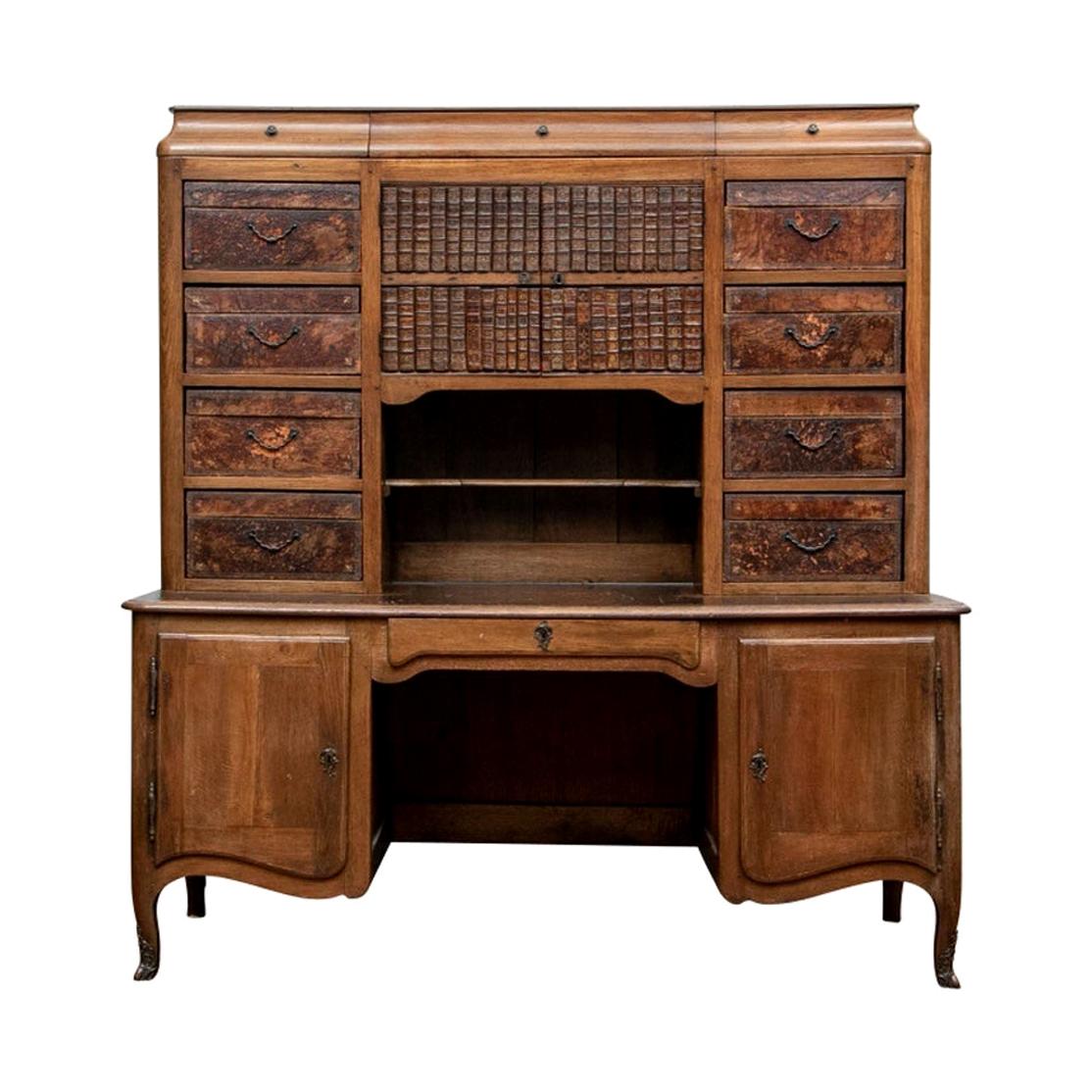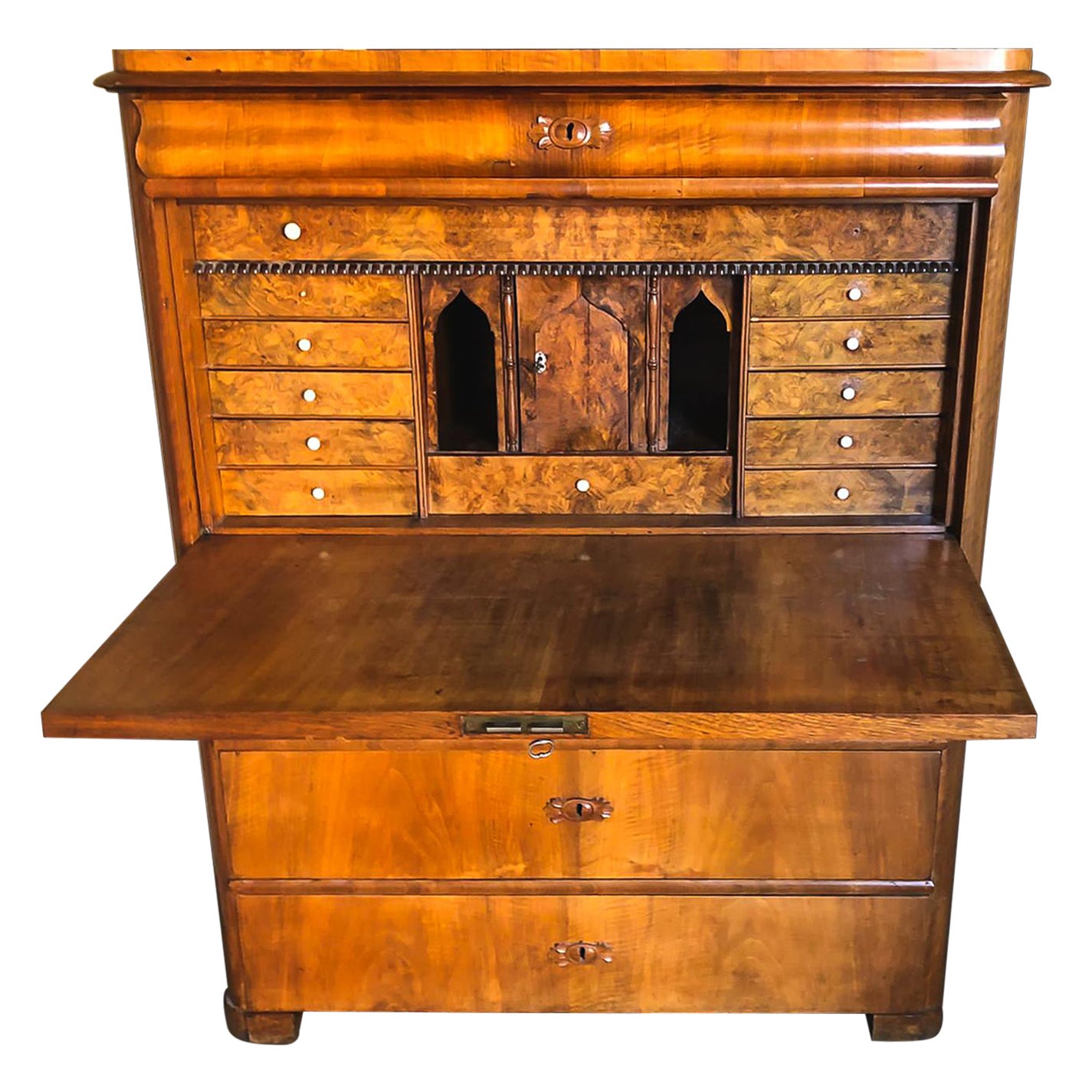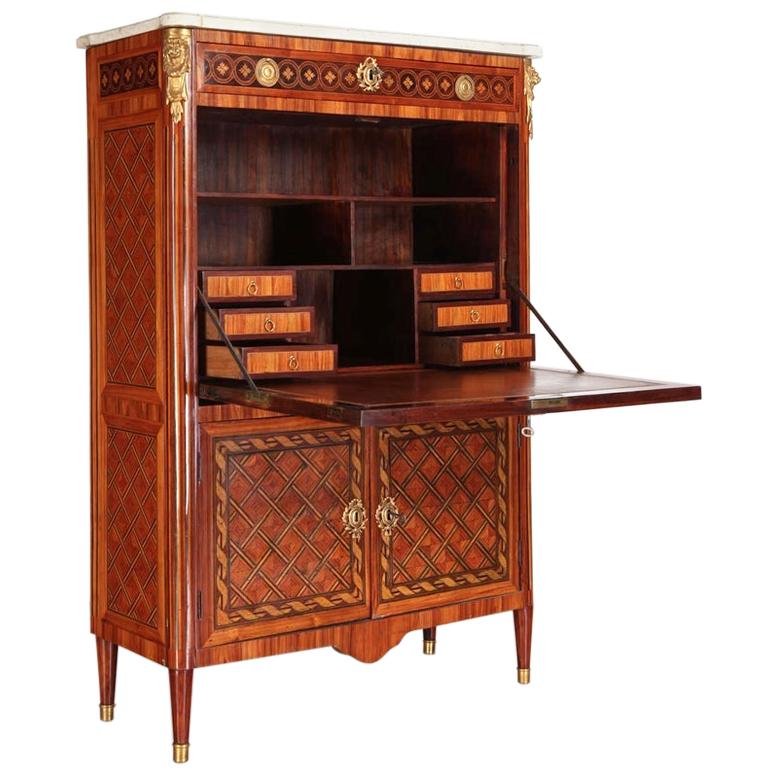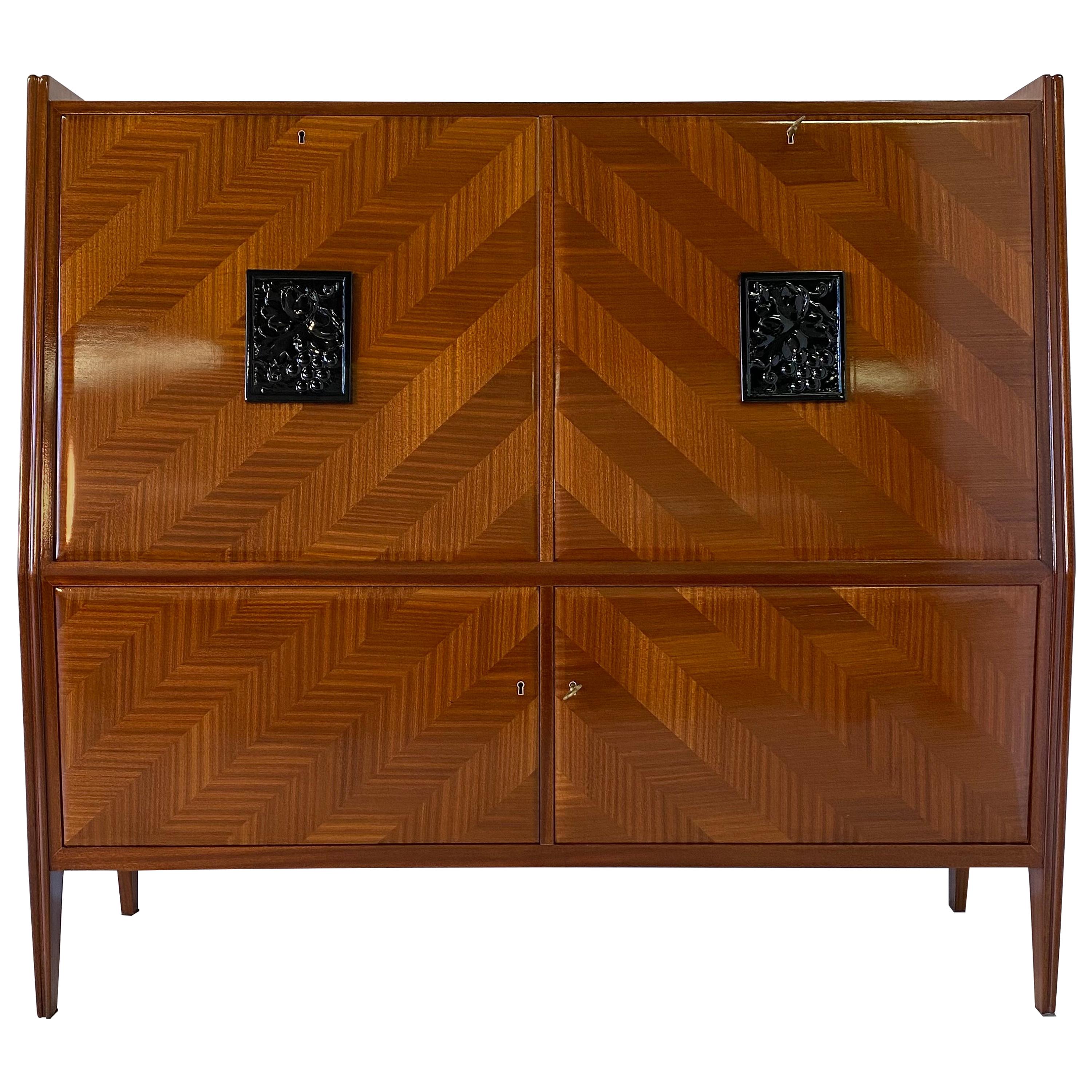Items Similar to Antique Specimen Cabinet, French Oak Cupboard, Secretaire, Desk, circa 1850
Want more images or videos?
Request additional images or videos from the seller
1 of 9
Antique Specimen Cabinet, French Oak Cupboard, Secretaire, Desk, circa 1850
About the Item
This is an antique specimen cabinet, a French, oak cupboard offering a secretaire desk dating to the late 19th century, circa 1850.
In a desirable French country style
Complete with original working locks and keys
Crafted in oak with grain interest and a desirable aged patina.
Raised on a shaped plinth base with field panelled sides
Two part cabinet, a division three quarters of the way up in the field panelled doors
The upper section hinges down providing a useful work surface
Backed by a bank of nine, small, oak lined drawers each dressed with brass pulls
The lower section doors open on pin and barrel hinges
To reveal a '2 over 2' configuration of larger drawers
Dressed with oval, pressed brass plate, drop handles.
A charming country piece delivered waxed, polished and ready for the home.
Dimensions:
Max width 85cm (33.5'')
Max depth 56cm (22'')
Max height 93cm (36.5'').
- Dimensions:Height: 36.62 in (93 cm)Width: 33.47 in (85 cm)Depth: 22.05 in (56 cm)
- Style:French Provincial (Of the Period)
- Materials and Techniques:
- Place of Origin:
- Period:
- Date of Manufacture:circa 1850
- Condition:Wear consistent with age and use. Presented in good antique condition.
- Seller Location:Hele, Devon, GB
- Reference Number:
About the Seller
5.0
Platinum Seller
These expertly vetted sellers are 1stDibs' most experienced sellers and are rated highest by our customers.
Established in 2005
1stDibs seller since 2017
840 sales on 1stDibs
Typical response time: 1 hour
- ShippingRetrieving quote...Ships From: Hele, Devon, United Kingdom
- Return PolicyA return for this item may be initiated within 14 days of delivery.
More From This SellerView All
- Antique Pedestal Cabinet, English, Column, Nightstand, Cupboard, Victorian, 1850Located in Hele, Devon, GBThis is an antique pedestal cabinet. An English, flame mahogany and marble nightstand cupboard, dating to the early Victorian period, circa 18...Category
Antique Mid-19th Century British Cabinets
MaterialsMarble
- Antique Carved Breton Buffet Cabinet, French, Sideboard, Oak, circa 1880Located in Hele, Devon, GBThis is an antique carved Breton buffet cabinet. A French sideboard crafted in oak in the late 19th century, circa 1880. An ornate example of French, ...Category
Antique Late 19th Century French French Provincial Cupboards
MaterialsOak
- Antique Georgian Corner Cabinet, English, Oak, Wall Hanging Cupboard, circa 1780Located in Hele, Devon, GBThis is an antique Georgian corner cabinet. An English, oak wall hanging cupboard, dating to the late 18th century, circa 1780. Plea...Category
Antique Late 18th Century English Georgian Cabinets
MaterialsOak
- Antique Secretaire Cabinet, English, Chest of Drawers, Bureau, Desk, GeorgianLocated in Hele, Devon, GBThis is an antique secretaire cabinet. An English, mahogany chest of drawers with drop front writing desk, dating to the Georgian period, ci...Category
Antique Late 18th Century British Cabinets
MaterialsWood
- Antique Display Cabinet, Victorian, Flame Mahogany Vitrine, circa 1850Located in Hele, Devon, GBThis is an antique display cabinet. An English, Victorian, flame mahogany vitrine dating to the mid-19th century, circa 1850. Magnificent Vic...Category
Antique Mid-19th Century English Victorian Vitrines
MaterialsMahogany
- Antique Bureau Cabinet, English, Edwardian, Walnut Cupboard, circa 1910Located in Hele, Devon, GBThis is an antique bureau cabinet, an English, Edwardian, walnut cupboard dating to, circa 1910. A craftsman's piece in solid walnut Delight...Category
Early 20th Century English Edwardian Cabinets
MaterialsWalnut
You May Also Like
- Notable French Secretaire Cabinet With Leather Bound Doors And DrawersLocated in Bridgeport, CTA secretaire a deux corps with a tall separately made upper cabinet. The top with three curved drawers over double doors with French leather bound book spines, 18th century. Opening to a chinoiserie wall papered...Category
Antique 19th Century French French Provincial Secretaires
MaterialsLeather, Wood, Paper
- Biedermeier Writing Desk Chiffonier Secrétaire Cabinet Swedish Ormolu DetailLocated in LONDON, GBSwedish antique Biedermeier writing desk chiffonier secrétaire cabinet in highly quilted golden birch veneers and finished in the Classic light h...Category
Antique Late 19th Century Swedish Biedermeier Secretaires
MaterialsBirch
- French Ormolu-Mounted Marqueterie Secretaire Abattant, Cabinet, 1775Located in Rome, ITImportant French ormolu-mounted, kingwood, tulipwood and stained sycamore marqueterie and parquetry secretaire abattant with rectangular moulded white marble top, above a frieze draw...Category
Antique 18th Century French Louis XVI Secretaires
MaterialsWood
- Charles Spooner Arts & Crafts Oak secretaire Cabinet with Serpentine StretchersBy Charles SpoonerLocated in London, GBCharles Sydney Spooner, probably made by J H Brandt. A rare oak secretaire cabinet on stand, with quarter veneered panels to the doors and drawers with black and green diamond shaped handles. The doors open to reveal adjustable shelves. The sides and lower stand are all made from solid quarter sawn oak with beautiful figuring. The slightly graduated mouldings to the waist frame the tidy little writing area. Standing on squashed ball feet, united with serpentine entwined stretchers. This is an oak variation of the cabinet Charles Spooner exhibited at the Arts and Crafts Exhibition Society in 1910. One can see that both cabinets are essentially the same design, one with drawers one with a pull down writing area. Both have quartered veneered panels to the doors, the Mahogany one with applied moulded decoration to the doors. See : illustration below from : Arts and Crafts Furniture by John Andrews. See also : Charles Spooner Arts and Crafts Architect, page 209 illustration 10:28. : Fine Art Society for a Coromandel variation and Puritan Values : Important Furniture Page 1, for a larger four door lacquered panelled variation. Charles Spooner is noted as one of the most influential people and also credited as one of the fathers of the Arts and Crafts Movement. Born at St Mary's Hospital, Paddington (London), Spooner was the second of 5 children of Charles Spooner and Sarah Frances Trinder, who lived at Brook Green, Hammersmith. Spooner became an architect and an instructor of furniture design at the London County Council's Central School of Arts and Crafts. He was a pupil and then assistant of Sir A W Blomfield and in 1890 won the RIBA’s Soane Medallion (Proc RIBA). He specialised in smaller churches and houses turning out some beautiful and complete buildings. He was influenced by E W Godwin and contemporary American architects such as H H Richardson. He was a member of the Society and Protection of Ancient Buildings and the Art Workers Guild, he worked in the tradition of William Morris, teaching...Category
Vintage 1920s English Arts and Crafts Cabinets
MaterialsOak
- Italian Mahogany Secretaire Cabinet, 1950sLocated in Meda, MBPrecious cabinet secretaire produced in Italy in the 1950s, The whole cabinet is veneered in mahogany with a fine solid wood carving in the center of the two doors representing two b...Category
Vintage 1950s Italian Mid-Century Modern Cabinets
MaterialsMahogany, Maple
- King George I Ambassadorial Secrétaire-CabinetLocated in New Orleans, LAThis highly important secrétaire-cabinet was crafted for and specially ordered by King George I for the British Ambassador to Russia. From its craftsmanship and materials to its exceptional artistry, it is a work of royal and historic significance that exudes power in each and every detail. The broken pediment at its apex features the simplified royal coat of arms bearing the king’s crown, while the interior is adorned by portraits of the British Royal Family. Placed within the ambassador’s St. Petersburg home, this entirely unique piece of furniture would have been a potent reminder of England's grandeur and political importance. Relations between England and Russia during this period were at an all-time high. Peter the Great had traveled to England in 1698 as part of his widely known “Grand Embassy” tour, wherein he attempted to gain foreign support against the Ottoman Empire. He spent a period of nearly four months there, meeting with King William III and his court on numerous occasions. Noted academic Arthur MacGregor wrote concerning the impact of the trip, “For two decades following Peter's visit, British influence in Russia reached a peak. It manifested itself in social custom, in craft practice and in ships and naval organization... it reached a significant sector of the population before relations cooled once again and the two nations pulled back from this era of unprecedented cordiality.” First and foremost, however, it is a reminder of British might and influence. By the reign of King George I, England had come into its own as a world power. Unique in its design, this cabinet is a reflection of the country’s might. It is crafted from the highest-quality solid walnut and burr walnut adorned by gilded lock plates and engraved hinges. The presence of ormolu at its apex and lining the doors was a rarity for this period, and its addition makes manifest the importance of the design. The outer doors open to reveal multiple interiors, including fifteen separate drawers around a central cupboard; the cupboard doors each bear mezzotint portraits of George I and his father, Ernest Augustus, Elector of Hanover. An etching after the portrait of George I dating to circa 1716 is in London’s Royal Academy. A second, inner pair of doors are adorned by mezzotints of the Prince and Princess of Wales (later Queen Caroline and George II), which are both after portraits by Sir Godfrey Kneller dated 1716 in the Royal Collection. A final portrait is revealed on the very interior of the cabinet, where a mezzotint of Frederick, Anne, Amelia and Caroline, children of the Prince of Wales, resides. An etching (circa 1715-1720) after this portrait can be found in the National Portrait Gallery (London). Apart from its abundance of royal portraiture, the cabinet features stunning painted decoration, including floral designs as well as clouds, birds and trees in a bucolic motif reminiscent of Eden. Its lower portion is a study in both form and function, featuring a fitted secrétaire-drawer above three additional drawers for storage. The cabinet appears in The Shorter Dictionary of English Furniture by R. Edwards from 1964, a text that is regarded as the bible of British furniture design. Edwards describes it as a “writing cabinet...given by George I to the British Ambassador at the Russian court.” The cabinet was likely made for the 18th-century German diplomat and writer Friedrich Christian Weber, who represented English interests at the Russian court from 1714 until 1719. Although Weber’s tenure as ambassador was relatively short, while in St. Petersburg, he authored his account entitled Das veraenderte Russland (The Present State of Russia), which was published in three volumes in 1721, 1739 and 1740. It may, however, also have been made for George Douglas, 2nd Earl of Dumbarton, who served as ambassador alongside Weber in 1716. Diplomatic relations ceased between the two countries in 1721. In 1928, the cabinet appeared for sale at the International Exhibition of Antiques & Works of Art in Olympia. It had previously been in the collection of the Woltner family of Bordeaux, the celebrated vintners who owned the estate Château Laville Haut-Brion and produced wine of the same name. According to the family, Monsieur Woltner was given the cabinet as a gift from an aunt who lived in Russia for many years. After leaving the Woltner collection, the cabinet was acquired by William Berry...Category
Antique 18th Century English Georgian Secretaires
MaterialsBrass
Recently Viewed
View AllMore Ways To Browse
French Cabinet Oak
Antique French Storage Cabinets
French Furniture 1850
Antique French Oak Cabinet
Storage Cabinet Oak Antique
French Open Storage Cabinet
Small French Cabinet
French Polish Cabinet
Antique Cabinet Base
French Base Cabinet
Small French Storage Cabinet
Two Part Cabinet
Small A Antique Cabinets
French Work Cabinet
French Two Piece Cabinet
Small Oak Cabinet
Antique Key Crafts
Used Oak Cupboards





